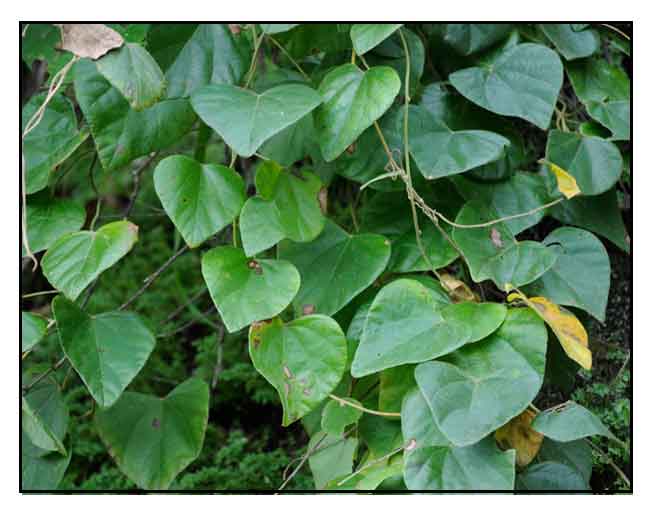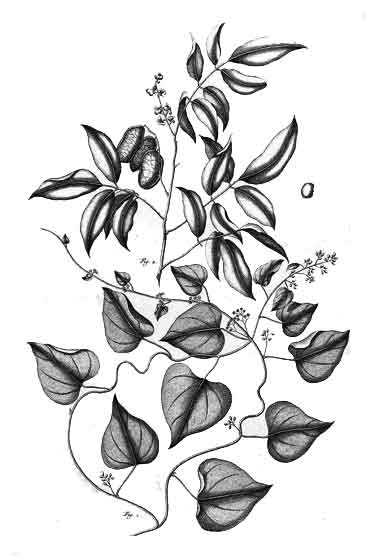|
 Botany Botany
Silong-pugo is a climbing shrub, with hairy
branchlets when young. Leaves are thin, pale or subglaucous
beneath, broadly ovate or nearly round, 5 to 8 centimeters wide, truncately
rounded or heart-shaped at the base, sometimes slightly peltate, and pointed at the apex, with
5 basal nerves, and tomentose. Cymes or panicles are 2- to 3-chotomous. Flowers
are numerous and yellow. Fruit is rounded, pea-sized, red or purplish, becoming
black when ripe. Seeds are kidney-shaped, with crested
edges.
Distribution
- Throughout the Philippines
in open thickets at low and medium altitudes.
- Also reported in India through Malaya to the Moluccas.
 Constituents Constituents
- Study of aerial parts yielded four new hasubanane-type alkaloids, periglaucines A-D (1-4), three known alkaloids, norruffscine (5), (-)-8-oxotetrahydropalmatine (6), and (-)-8-oxocanadine (7). (see study below) (1)
-
Study yielded 5 triterpenes: hopenone-B, hopenol-B, 22-hydroxyhopan-3-one, erythrodiol 3-palmitate, and 5β,24-cyclofriedelan-3-one. (see study below) (3)
- Study of ethanolic extract of leaves for total phenolics and total flavonoids content yielded 52.51 mg/gm with percentage yield as 5.20% w/w mg gallic acid equivalents/g and 51.70 mg/gm with 5.17% yield w/w mg rutin equivalents/g, respectively. (see study below) (12)
- Phytochemical screening of various extracts yielded plyphenols such as tannins and flavonoids, terpenes, sterols, alkaloids and saponins.
(see study below) (17)
- GC-MS study of fraction of ethanolic extract of leaves
yielded 10 compounds. The most dominant was benzoic acid, 5-methoxy-2- [(trimethylsilyl)oxy]-,trimethylsilyl ester (cas) 5-methoxy-salicylic acid-ditms, (7.95 %), followed by another benzoic acid, 2- [(trimethylsilyl)oxy]-,methyl-ester (cas), methyl-o-,trimethyl-silylsalicylate (7.43 %);propanoic acid, 2-[(trimethylsilyl)oxy], trimethylsilyl ester (3.57 %); butanedioic acid, bis(trimethylsilyl)- ,ester(cas) di-tms succinate, (0.63 %); vanilethanediol 3 (0.59%); acetic acid, [(trimethylsilyl)oxy]-,trimethylsilyl ester (cas)-glycolic acid-ditms (0.41 %), and (3-Hydroxy-4- , methoxyphenyl) ethylene glycol tris(trimethylsilyl) ether (0.30%); benzoic acid, 3-methoxy-4- , [(trimethylsilyl)oxy]-, trimethylsilyl ester, (0.25%), and 2-[(trimethylsilyl) oxy]-, methyl ester (cas) methyl-o-trimethyl-, silylsalicylate, (0.19%); and benzaldehyde, 3-methoxy-4- [(trimethylsilyl)-oxy]-, (cas) monotrimethylsilyl vanillin (0.17%).
- Study of rhizomes yielded six crystalline substances identified as epifriedelinol, melissic acid, palmitic acid, stearic acid, bututic acid and daucosterol.
(22)
Properties
- Roots are narcotic; contains
an alkaloid.
- Studies have suggested analgesic, antipyretic, anti-inflammatory, antiviral, antidiabetic, antihyperlipidemic,
antitumor, antihepatitis, anntimalarial, anticancer, antivenom, antiurolithiatic properties.
Parts
utilized:
Leaves and roots.
Uses
Folkloric
- Roots used as antidote for snake bites.
- Leaves applied to the head for headaches.
- Also used for asthma and coughs.
- In China, leaves used for treatment of tumors, itches, tetanus, eclampsia.
- In Malaysia, used for treatment of conjunctivitis.
- Used for rheumatic pains, fractures, boils, splenomegaly and tumors.
- Traditionally used as treatment of venomous snake bites. (17) Also used the treatment of fever, cough, laryngitis, pulmonary diseases, asthma, headache, hair loss, fractures, boils, tumor, tetanus, rheumatic pains, itches and eclampsia. (18)
- In Malaysia, traditionally used for the treatment of joint pain, abdominal pain and headaches. (20) Studies
• Periglaucines / Anti-Hepatitis
B / Anti-HIV Alkaloids: Study isolated four new hasubanane-type alkaloids,
periglaucines A-D (1-4) and three known alkaloids. Alkaloids 1-4 inhibited
hepatitis B virus (HBV) surface antigen (HBsAg) secretion in Hep G2.2.15 cells. Two alkaloids, norruffscine and (-)-8-oxotetrahydropalmatine, exhibited inhibitory activity against human immunodeficiency virus (HIV-1) with EC50 of 10.9 and 14.1 µM in C8166 cells, respectively. (see constituents above) (1)
• Chemical Constituents: Study of rhizomes yielded six cyrstalline substances: epifriedelinol, mellisic acid, palmitic acid, stearic acid, bututic acid and daucosterol. (2)
• Triterpenoidal Constituents / Antitumor Activity: Study yielded five triterpenes. Compound 4, erythrodiol 3-palmitate, inhibited the proliferation of K562 cells. (see constituents above) (3)
• Acute and Subacute Toxicity Studies: Study evaluated the safety dose range of ethanolic extract of leaves of P. glaucus in a BALB/c mice model. In acute toxicity testing, there was no mortality or any significant alteration in behavior other than drowsiness, sedation and lethargy at 2,000 and 4,000 mg/kg test dose of extract. In subacute toxicity testing, there no changes in hematological and biochemical parameters and organ body weight. Results suggest safety for therapeutic use of the extract in pharmaceutical formulations. (8)
• Antihyperlipidemic Potential: Study evaluated an ethanolic extract of P. glaucus on biochemical parameters in high fat-diet treated male Sprague-Dawley rats. Results showed different doses of the ethanol extract induced significant reduction in body weight, total cholesterol, TG,LDL, and uric acid levels, together with an increase in HDL. Results suggest antihyperlipidemic potential. (9)
• Amoebicidal Activity / Periglaucine A and Betulinic Acid: Study evaluated the amoebicidal effects of different fractions of Pericampylus glaucus against pathogenic Acanthamoeba triangularis isolated from environmental water supplies. Betulinic acid and periglaucine A from the plant inhibited more than 70% survival of both cysts and trophozoites. Therapeutic index of periglaucine A suggests it could be of value in the treatment of acanthamoeba infection. (10)
• Anti-Inflammatory Activity / Activity Against Nasopharyngeal Carcinoma: Study evaluated various extracts of stems, leaves, roots, and fruits of PG for anti-inflammatory activity. Results showed most of the extracts exhibited inhibitory activity towards both of the COX systems. Cytotoxicity was tested using human lung epithelial cell line MRC-5 and nasopharyngeal carcinoma cell line HK1 in MTT assay. (11)
• Antioxidant / Leaves: Study of crude ethanolic extract of leaves for antioxidant activity showed good radical scavenging activity on DPPH assay, but less than ascorbic acid standard. The extract showed concentration-dependent increase in reducing power. (See constituents above) (12)
• Anti-Diabetic / Antihyperlipidemic: Study evaluated the effects of PG extract on plasma glucose concentration and lipid profile in STZ-induced diabetic rats. In short- and long-term studies, results showed significant (p<0.01, p<0.001) anti-diabetic activity in normal and diabetic rats. There was also reduction in TC, TG, and LDL, together with improvement in HDL level. (13)
• Antidiabetic Compound: Study evaluated the antidiabetic activity of the compound benzoic 2-[{trimethylsilyl) oxy]-,methyl ester (cas) methyl o-trimethyl-silylsalicylate isolated by fractionation. In vivo study in STZ-induced diabetic rats showed the compound possesses significant hypoglycemic properties with a potential for use in the management of diabetes. (14)
•
Anitmalarial: Study screened plants that can effectively inhibit P. falcifarum 3D7, a common lab strain malarial parasite. Of 24 crude plant extracts, A crassifolius, L. eugeniifolia, and Pericampylus glaucus showed promising antiplasmodial activities at IC50 of 15.32 to 39.75 µg/mL. Results suggest further studies to explore for efficacies and lead compounds. (15)
• Anti-Tumor Activity / Secondary Metabolites: Study isolated five triterpenoids viz., Hopenone-B (1), hopenol-B (2), 22-Hydroxyhopan-3-one (3), erythrodiol 3-palmitate (4) and 5β,24-cyclofriedelan-3-one(5). Compound 4 inhibited the proliferation of K562 cells with an inhibition rate of 47% at 100 µg/mL. (16)
• Antivenom / Antioxidant / Anti-Inflammatory / Wound Healing: Study showed antivenom activity with the fruit hexane extract increasing cell proliferation by over 50% at 200 µg/mL and the alkaloid periglaucine A increasing proliferation by over 70% suggesting significant antivenom activity, with the fruit extract showing stronger antivenom activity than the roots. Antioxidant activity by DPPH assay correlated with total polyphenol content. Study also showed toxicity towards cancer cells. Wound healing activity was attributed to its ability to promote cell proliferation and migration and to its antibacterial activity. (17)
|• Periglaucine A / Anti-Inflammatory / Nasopharyngeal Carcinoma:Study evaluated various extracts of stems, leaves, roots and fruits of P. glaucus for anti-inflammatory activity and cytotoxicity using human lung epithelial cell line MRC-5 and nasopharyngeal carcinoma cell line. Many of the extracts showed an ability to prevent heat induced protein denaturation and prevent lysis of red blood cells. Most of the extracts showed inhibitory activity towards both of the COX enzymes. Ethanol extracts demonstrated greater toxicity than other extracts, some significantly enhancing growth and metabolism of the cells. (18)
• Antiurolithiatic Effect / Ethylene Glycol Induced Urolithiasis: Study evaluated the antiurolithiatic effect of an ethanol extract of P. glaucus against ethylene glycol induced urolithiasis in male Sprague Dawley rats. Results showed significant (p<0.01) decrease in hyperoxaluria, calcium, phosphate, oxalate with significant (p<0.05) increased retention of urinary magnesium and improvement in renal function, along with smaller depositions of calcium oxalate crystal in the treated group. (19)
• Analgesic / Antipyretic / Anti-Inflammatory: Study evaluated an ethanolic extract of P. glaucus for analgesic, antipyretic and anti-inflammatory activities. On analgesic evaluation, there was significant (p<0.01) inhibition in writhing response in acetic acid induced writhing and dose-dependent (p<0.001) prolonged paw licking in hot plate test, There was significant (p<0.001) attenuation in lowering rectal temperature, comparable to that produced by ibuprofen The extract also produced significant reduction in hind paw edema (p<0.001) after carrageenan administration. Results suggest potential for use in the management of fever, pain, and inflammation. (21)
Availability
Wild-crafted.
|


 Botany
Botany Constituents
Constituents

